

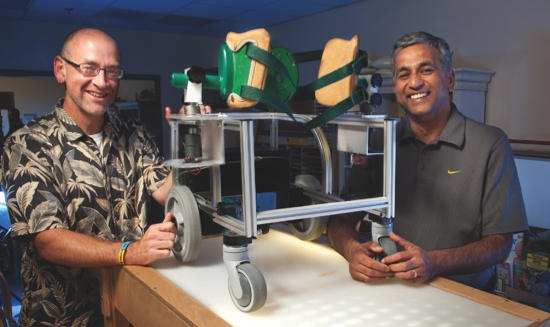
hen Cole Galloway takes his research show on the road, one of his favorite things to share with his audience is a video of a newly mobile baby wreaking havoc in a living room filled with toys. Galloway heightens the effect by showing the movie at triple speed so that the audience quickly becomes as exhausted as both the baby and her parents are at the end of the day.
As a physical therapist and developmental scientist, Galloway knows that the basic movement behaviors of kids between the ages of one and three — the so-called toddler years — are more than just movements. The continuous stream of activity is a complex “exploratory engine” that children use to build bigger, better bodies, construct more complex brains, form their first friendships and lay the foundation for school readiness.
“Adults have long recognized that children’s brains and behavior expand during the early years,” Galloway says. “More recent is the recognition that their mental, social and emotional development is intimately linked to their physical and social exploration of the world. For adults trying to keep up with a toddler, exploration can be simultaneously frustrating, exhausting and exhilarating.
“Toddlers will paint your new furniture with chocolate pudding, force pants into the dishwasher and try to ride the cat — and that’s all before breakfast,” he continues. “As a developmental scientist, I’m interested in quantifying the who, what, when, where, why and how of these ‘babies gone wild.’ As a clinical scientist, I want to help create the technology with special needs training that will allow children with special needs to become wild, and all families to discover the ‘engines’ within their children.”
To Galloway, the exploration gap between typically developing children and children with mobility issues is simply unacceptable, and he has devoted much of his career to doing something about it. Several years ago, he began working with mechanical engineering professor Sunil Agrawal to develop robot-enhanced devices that provide mobility to children as young as six months.
UD was the ideal place to launch their collaboration. Agrawal’s Mechanical Systems Laboratory provided the “manufacturing plant” for the vehicles, while the University’s Early Learning Center (ELC) provided the young drivers, indoor and outdoor “test tracks,” and expert early educators and pediatric therapists such as Tracy Stoner and Terri Peffley.
The data collected using robots developed in the first phases of the project convinced Galloway and Agrawal that they were on the right track.
“Driving Sunil’s robots literally provided children who were not crawling or walking with a vehicle for exploration,” Galloway says. “The onset of crawling and walking is a causal factor for cognitive, emotional and social development. Powered mobility via driving appears to be a similar trigger for developmental change in young children who are not walking.”
“Mobility and socialization typically co-develop over the first two years of life,” he adds. “If they don’t, the child may end up with ‘splinter’ skills in which mobility and socialization emerge separately.”
As Galloway and his team discovered when they placed a mobility robot in an ELC preschool class, children who have experienced several years of immobility may learn to drive without understanding how to use their newfound mobility to play with friends or with teachers.
“We realized then that we needed to start our driver training during infancy, in activities with other children and always in natural environments such as the ELC,” he says. “Our hope is that mobility and socialization will co-emerge for the driving toddler, just as it does for the walking toddler.”
By 2010, the science and technology in the project were emerging, but the pace was a challenge for Galloway. With no new commercial devices on the market to provide early power mobility, he became increasingly frustrated at his inability to help parents, clinicians and educators who were excited about the work but wanted help for their children now.
“We were moving at the speed of science, which is of course acceptable at some level,” he says. “However, constantly saying ‘no’ to a community asking if we had robots for their children or clinic began to drive me a bit nutty.”
Galloway is a bit of a toddler himself. Like a child in the throes of the “terrible twos,” he doesn’t like the word “no.” So he adopted another behavior common to devious youngsters — if dad says no, ask mom … or better yet, climb up and get it yourself.
One day about a year ago, he found himself at Toys“R”Us admiring a colorful array of plastic ride-on cars and trucks. After purchasing an assortment of the inexpensive vehicles, he went to Jo-Ann Fabric & Crafts and Home Depot, where he bought fabric, foam, straps, fasteners and PVC pipe. Back on campus, Galloway and his students began using the materials to customize the cars for use by individual kids.
Babies Driving Robots had spun off a new project: Babies Driving Racecars.
Galloway says the low-tech is not replacing the high-tech but complementing it.
“Like children, scientists thrive on trial-and-error learning cycles,” he says. “For real impact, you want those cycles to be rapid and cheap with clear, meaningful results. By modifying off-the-shelf toy cars, we can make lots of low-cost mistakes and quickly arrive at a range of ideal design features. That knowledge can then be fed back into Sunil’s ongoing robotics work.”
Galloway’s inner toddler was becoming a bit calmer.
“Marrying the high-tech to the low-tech is leading us to new ‘Go-Tech’ possibilities in which scientific rigor is strapped to a racecar,” he says.
The ubiquitous presence of the cars is also paving the way for globalization of the program. “It’s not uncommon to find distributors of ride-on toy cars in countries that don’t have stable governments or clean water for their citizens,” Galloway says. “This takes us from having two robots in house here at UD to millions of toy cars around the world. The potential for such rapid globalization stretches our creative thinking about car modification design as well as our scientific methods.”
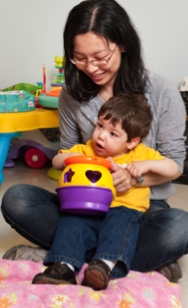
The project is also providing a rich learning environment for graduate student Christina Ragonesi and postdoctoral researcher Hsiang-han (Sara) Huang.
Ragonesi is working simultaneously on a doctorate of physical therapy degree in UD’s nationally ranked physical therapy program and a Ph.D. in the Biomechanics and Movement Science Program. When Galloway challenged her and Huang to design a car that works a child’s leg strength and standing balance, she instrumented the seat of a toy car so that the car goes forward only if the child stands and instantly stops if he sits back down. “Kids will work hard to stand and keep standing if it means they can get the car to move,” she says.
Huang joined Galloway’s group in August 2011 after earning her research doctorate at Boston University.
“I chose Dr. Galloway’s lab because of his determination to incorporate creative ideas into the clinical field and his focus on empowering the family,” Huang says. “This type of research not only helps families directly but also provides evidence for moving forward scientifically.”
“Every week, families in our research share with me what they have observed about their children’s performance, and I encourage them to become involved in modifying the cars,” she continues. “They have their own interesting ideas about how to incorporate the cars into their kids’ everyday lives. As a researcher, I can imagine no better outcome — it means we’re helping to orchestrate positive changes for children and their families.”
Since arriving at UD in 2000, Gallo-way has also involved hundreds of undergraduates and high school students in various projects. Last summer, for example, 16-year-old David Glanzman engineered some electrical and mechanical modifications by adapting a “Mater” truck so that it would meet the needs of then-19-month-old Brenden, who has cerebral palsy (see p. 43). With plans to pursue a career in electrical engineering, Glanzman gained valuable insight into what happens when engineering meets kids.
“In electrical engineering, you have problems with defined solutions,” he says. “It’s different with pediatrics. Kids are dynamic, and they change over time — you have to be creative to adapt to that.” Glanzman is set to return this summer to continue his work.
One of Galloway’s current goals for the racecar project is to take what he and his team are learning and create a toolkit for families, medical and educational professionals, and researchers who want to adapt the cars for kids with special needs. He emphasizes the importance of doing this right.
“We make sure to stay within the manufacturers’ intent, which is to use these cars as toys,” he says. “They’re not medical devices. We don’t alter their use, and we don’t alter the safety factors built into the cars. In fact, several of our modifications increase the safety for children with special needs.”
The next step is to determine how many of the high-tech advances that have been incorporated into the robotic devices developed in Agrawal’s lab can be added back to the low-tech platform. Potential add-ons include force and motion sensors, GPS and other performance-tracking capabilities such as onboard microcomputers and web cameras. This will allow laboratory-grade data gathered from living rooms, playgrounds and backyards around the world to be sent back to the UD lab.
Several years ago, Galloway and Agrawal envisioned programming a device to take a child to the edge of a group, to just wander or to follow a specific child or an instrumented toy such as a ball. “This capability would enable us to place the child in the flow of the social scene and see what happens,” Galloway says. “Sunil and Xi Chen, his graduate student, are conducting this project on socially mobile robotics right now at the ELC with our mobile robot.” If this is successful, Gallo-way plans to implement the same concept with racecars for children who have social impairments such as autism.
Right now, his overriding goal is to get the technology into every possible environment where kids are — from homes and playgrounds to preschools and even long-term care facilities for medically fragile children.
“This project demands that our research stay nested deeply within the community,” Galloway says. “Discussing the technology and training of powered mobility with community audiences, from third graders to business leaders, is a key connection. This project has something for everyone.”
Galloway emphasizes that in both the low- and high-tech realms of his research, the use of mobility devices never replaces efforts to develop a child’s own ability to walk and run.
“Providing mobility and exploration with these cars likely helps encourage their exploratory ‘drive,’” he says. “For example, typically developing infants who spent 30 minutes a few times a week driving, crawled and walked early, as well as had advanced cognitive and language scores. Our future work needs to test this with children with special needs.”
Galloway never stops looking for creative ways to help individual children while also seeking avenues to spread the message and the technology to parents and clinicians. One idea he is currently exploring is to pilot racecar camps. The research team would outfit the campers with cars, spend a week teaching them to drive, and then send the kids and cars home. The children’s progress would be monitored for the next six to nine months.
“Fun is the beginning and the end for our science,” Galloway says. “Our entire pediatric mobility program is built on a foundation of maximum fun and discovery. When your main goal is providing socialization for infants and toddlers, you can’t ask for better collaborators than Barbie and Mater.”
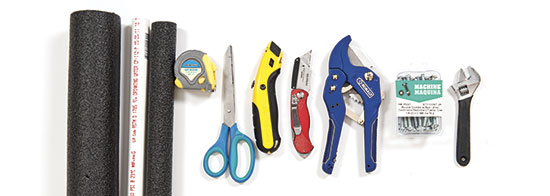
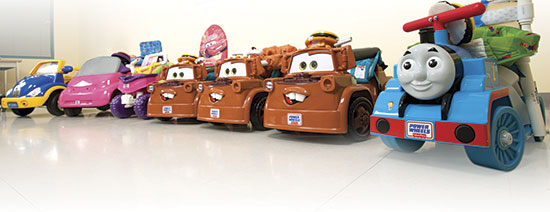
Hover your mouse over or touch a point below to learn more about the 2020 DARE2B prototype
Biodriven mobility unit supports driving and walking.
Driving Module (shown) converts to Power walker to provide maximum mobility.
Steering, seating and acceleration, options enable modifications to fit any child's abilities.
Device is small, light and rugged for indoor/outdoor all-weather use.
Force and motion sensors assist mobility, socialization and learning
Unit relays child's daily mobility and socialization performance to UD HQ.
Brenden Bolen’s Mater truck wasn’t a birthday present, but the plastic ride-on vehicle was a gift of another sort – it enabled the two-year-old to be in the middle of the fun with the guests at his party.
For Brenden, who has cerebral palsy, Mater is more than a toy. It’s an avenue to the socialization and exploration he would otherwise miss out on. It’s an entrée into the world of kids. It’s the first step toward turning him into a knucklehead.
And when you’re two years old, you’re supposed to be a wonderful knucklehead.
His customized car has opened the door for Brenden to interact with other toddlers at UD’s Early Learning Center. At home, it’s enabled him to play ball with his dad and pet a therapy dog from Paws for People.
“He absolutely loves it,” says his mother, Kimmy Burge. “His favorite thing is to go outside with the car, and all of the kids think it’s great that he has Mater.”
Prof. cole Galloway sees family involvement as a critical element in driving success.
“It’s best when not only the parents but also the grandparents and the rest of the extended family play an active role,” he says. “In Brenden’s case, his family took the reins and floored us with how fast they wanted to move forward.”
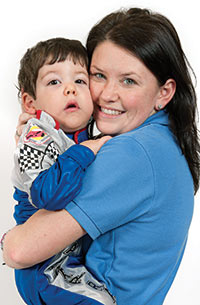
Galloway likens the racecar project to Habitat for Humanity on a miniature scale. “Adapting a car to meet the child’s needs is a chance to become invested in building something,” he says. “Families can actively participate – helping modify the car allows them to physically work to help their child.”
Mater is part of research that tracks Brenden’s progress quantitatively, and his mother already has anecdotal evidence that the car is driving Brenden’s development.
“I’ve seen big changes in him since he started driving Mater,” she says. “He’s more alert, he reaches more and he has better head and trunk control. When he gets in the car, he knows exactly what to do.”
Kimmy realizes that Brenden will soon outgrow Mater, but she’s not worried. “After seeing how it’s done in the lab at UD, I know we can adapt another, larger car ourselves,” she says. “And i’m sure they’d be happy to help us – they’ve been extremely accommodating to us throughout this whole process.”
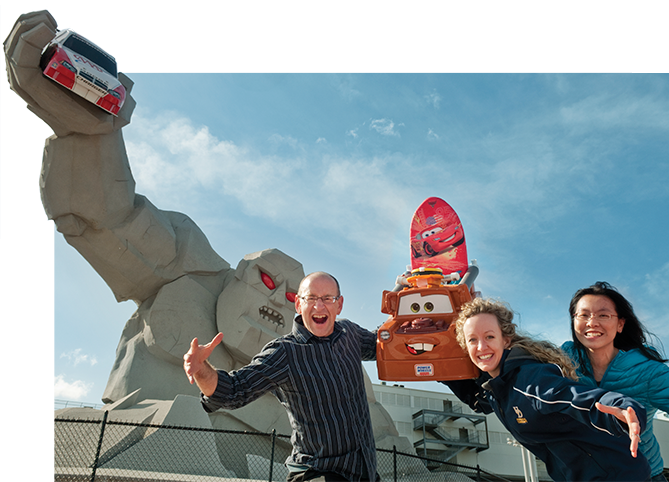
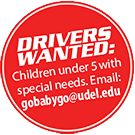
One community sector that cole Galloway recently connected with is the world of auto racing. with Dover international speedway less than 50 miles from the UD campus, he saw potential for a collaboration with Dover Motorsports inc. The organization has strong ties to Autism Speaks, which could provide the perfect window for the racecar project.
“Racecars may offer children with autism a mode of play with the physical space that they need to be emotionally comfortable while enabling them to engage in a fun activity typical of their peers,” Galloway says.
Gary camp, senior director of communications for Dover international speedway, has already seen the positive effect of the car connection. “a parent whose child has autism recently told me that his kid has become who he is because of NASCAR – he knows all the drivers and their numbers and their cars. Kids learn through the sport – they love the cars and the speed, and they end up learning and becoming engaged as a result.”